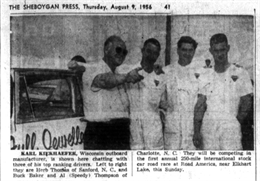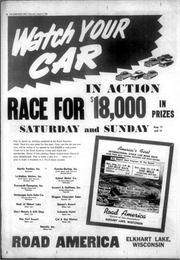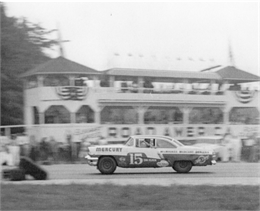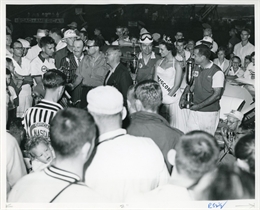A NASCAR First at Road America
1956 Grand National Competed on Paved Road Course

The NASCAR Grand National cars stream out of Turn Five shrouded in spray during the first lap of the 1956 Grand National race at Road America. Courtesy of Road America Archives.
In 1956, the top stock car racing series in the country, the NASCAR Grand National series, came to Road America. It was historic, the first time NASCAR raced on a paved road course.
For NASCAR drivers and their cars, the event promised to be a new challenge. For Road America, it was a marked departure from previous sports car events. NASCAR’s appeal was in racing cars based on those most Americans owned. Held August 11-12, 1956, the weekend was an extravaganza, featuring the NASCAR Grand National race on Sunday, qualifying runs, and a supporting race for small cars the day before, as well as a celebrity gala, beauty contest, and the crowning of the first Miss Road America.
The event came about because NASCAR founder Bill France, Sr. was eager to expand north, Clif Tufte was in search of a new racing event for Road America, and it would be a win for both. It was probably no coincidence that NASCAR’s top race team, Carl Kiekhaefer’s Mercury Marine team from nearby Fond du Lac, would certainly welcome a home race.

Mercury Marine team owner and operator Carl Kiekhaefer of Fond du Lac with his drivers, Herb Thomas, Buck Baker, and Speedy Thompson before the 1956 NASCAR Grand National race at Road America. Sheboygan Press, August 9, 1956.
NASCAR’s big hook was stock cars – American production vehicles just like those anyone could buy. Fans could easily identify with a familiar make and model, especially if it was like the one parked in their garage. Dwight Pelkin, sports reporter for the Sheboygan Press, described the appeal in his August 7, 1956 column:
"Every guy who runs a Mercury around town will undoubtably be rooting for the "Merc" boys to wheel their jobs home first. And the same with the Chevy and Ford and Dodge owners - they'll all have a sort of personal stake in the races, hoping that their own stock models can beat others. It's only natural."

Full page “Watch Your Car” advertisement leaned heavily into the stock car appeal promoted by NASCAR. News articles promoted the race as “The biggest race program of the season,” and “The most exciting race of the year.” Sheboygan Press, August 8, 1956.
Anticipating the challenge of the Road America course, NASCAR teams arrived early to practice and become familiar with the track. Drivers liked the track, but recognized it was a new challenge, Road America’s demanding terrain and corners requiring different skills than oval tracks.
Some sports car drivers were skeptical that stock cars might not be up to the rigors of the demanding Road America road course, and were concerned about the stock cars’ brake performance and reliability.
Others questioned stock car driver’s skill and experience. The Wisconsin State Journal August 5, 1956, put it most bluntly:
"...But the hub of it, everyone here concedes, is that it will take a top-notch man to wheel an everyday auto around this course. This is no fairgrounds oval, but a hilly, crooked, and rugged track designed to separate the men from the boys...”
Sunday morning started with pelting rain. Hardly ideal, and the NASCAR Grand National race featured all the chaos you’d expect from a wet, slippery track and ever-changing conditions: spinouts and off-course excursions into the haybales that lined the runoff areas around corners.
Pitstops were a certainty. Cars were limited to a maximum fuel load of only 10-gallons, requiring drivers to refuel at least twice just to finish the race. After many lead changes, 1955 NASCAR champion Tim Flock took the checkered flag in his Mercury.

Tim Flock, racing past the Road America Pagoda, takes the checkered flag to win Sunday’s NASCAR Grand National race in his 1956 Mercury. Courtesy of Road America Archives.
Dwight Pelkin credited Flock’s win to steady driving and fast pit stops.
"Flock drove a canny, brilliantly-planned race. Always among the leaders but seldom closer than fourth or fifth for the first half of the run, he kept tooling off steady 3:17 lap times (73 miles per hour) minute after minute, avoiding mishaps so that, when his foremost rivals met trouble, he was ready to take advantage. Once given the chance, he never faltered. Between his sharp driving technique and some genuinely awesome pit work by his Mercury crewmen (a dozen men swarmed over the Merk stable cars as they wheeled into the pits), he was the master."

Crowd of onlookers watch as winner Tim Flock and runner-up Billy Meyers are presented the winning trophies by 1956 Miss Wisconsin, Linn Byron Holden. Courtesy of Road America Archives
Saturday featured an intriguing 100-mile race for smaller American cars and foreign sedans. The strange and eclectic mix included a Mark VII Jaguar, two English Ford Zephyrs, a Studebaker, nine Renaults, four Volkswagens, and a DKW.
Americans hadn’t seen a stock car road race for smaller engine foreign sedans before.
Paul Goldsmith won in a Mark VII Jaguar. Surprisingly, he wasn’t entered until race day! According to Steve Zautke in his book NASCAR Road America, Goldsmith remarked:
"I was up there for the NASCAR race, and a fellow from New York, I think he was in advertising, asked me if I would drive his car. I said, 'Sure!' and I went on to win the race.” What a surprise!

Buck Baker, NASCAR’s 1956 Grand National points leader, gives advice to Gene Shermeister of Sheboygan, who entered his Volkswagen Beetle in Saturday’s small car race. Sheboygan Press, August 10, 1956.
Another surprise came from Gene Shermeister of Sheboygan who had not raced since 1939 and entered his Volkswagen Beetle. Shermeister got off to a bad start but recovered for a satisfying finish. “Never in contention as far as the top money went, he nevertheless hung in there and waged a series of duels with other middle-of-the-pack competitors to grab himself a very respectable eighth place out of 18 starters.” said the Sheboygan Press. Shermeister demonstrated that even a low-powered car could be raced successfully.

The first Miss Road America, Beverly Jo Springer behind the wheel of the 1957 Corvette Super Sport concept car at the National Automobile Show at the New York Coliseum, January 1957. Photo by Genack Studio, courtesy of Road America Archives.
Weekend festivities concluded with the crowning the first Miss Road America on Sunday night. Judges were an all-star celebrity team including 1956 “Miss Wisconsin” Lynn Byron Holden; "King of Jazz" orchestra leader Paul Whiteman; 1954 SCCA Champion Jim Kimberly; and noted woman racing driver and pilot Betty Skelton. 50 candidates vied for the title, and the winner was Miss Beverly Jo Springer of Beloit. Springer went on to represent and promote Road America at events around the country, such as the National Automobile Show in New York City.
Despite being an exciting race and experiment for both NASCAR and Road America, rain kept the crowds away. Attendance, estimated at less than 10,000 for the Grand National race, was dismal. It would be 54 long years before NASCAR returned in 2010 with the Nationwide Series, NASCAR’s second-tier series. It was a huge success. Since then, NASCAR events have drawn huge crowds, full campgrounds, hauler parades, and exciting support races. That success even led to the return of NASCAR’s premier Cup Series in 2021 and 2022. Today, fans look forward to future NASCAR events at the track.
[Sources: Interviews with Road America staff Tim Kemmis, John Ewert, Fall 2023. Schultz, Tom. Road America: Five Decades of Racing at Elkhart Lake. Indianapolis, IN: Beeman Jorgensen Inc., 1999; Schultz, Tom. Celebrating 50 Years of Road Racing. Elkhart Lake, WI: Road America, 2004; Zautke, Steve. NASCAR Road America. Charlestown, SC : Arcadia Publishing, 2013; "NASCAR To Hold Races At Elkhart." Sheboygan Press, March 24, 1956; "Nationally Renowned Judges To Pick 'Miss Road America." Sheboygan Press, July 30, 1956; "Driver Showdown Expected At Road America Next Week." Sheboygan Press, August 3, 1956; "Stock Cars 'Take Over' Road America." Wisconsin State Journal, August 5, 1956; Pelkin, Dwight. "It's This Way." Sheboygan Press, August 7, 1956; "50 Lovely Ladies Compete for Miss Road America.'" Sheboygan Press, August 8, 1956; "Colorful Virginian Drives More For Sport Than Cash." Sheboygan Press, August 9. 1956; "Advice from and Expert." Sheboygan Press, August 10, 1956; Vesey, Richard. "Stock Cars Roar At Road America." Wisconsin State Journal, August 11, 1956; "Stock Car Races Under Way Today." Sheboygan Press, August 11, 1956; Pelkin, Dwight. "Flock Drives Mercury to Stock Win." Sheboygan Press, August 13, 1956; "Beloit Beauty Wins Title at Road America." Sheboygan Press, August 13, 1956.]

